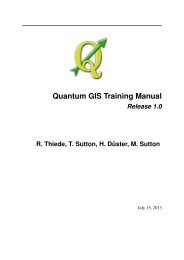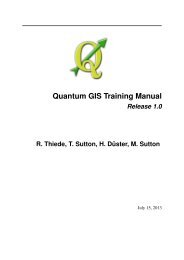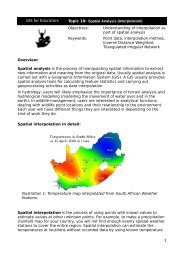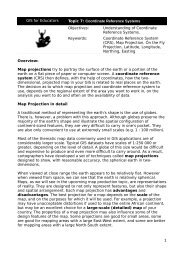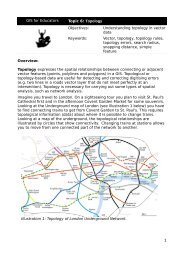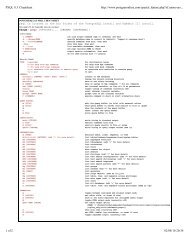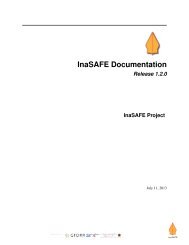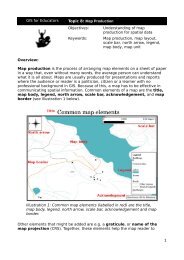PyQGIS Documentation - Linfiniti Geo Blog
PyQGIS Documentation - Linfiniti Geo Blog
PyQGIS Documentation - Linfiniti Geo Blog
Create successful ePaper yourself
Turn your PDF publications into a flip-book with our unique Google optimized e-Paper software.
12.3.2 plugin.py<br />
<strong>PyQGIS</strong> <strong>Documentation</strong>, Release 1.4<br />
One thing worth mentioning is classFactory() function which is called when the plugin gets loaded to QGIS. It<br />
receives reference to instance of QgisInterface and must return instance of your plugin - in our case it’s called<br />
TestPlugin. This is how should this class look like (e.g. testplugin.py):<br />
from PyQt4.QtCore import *<br />
from PyQt4.QtGui import *<br />
from qgis.core import *<br />
# initialize Qt resources from file resouces.py<br />
import resources<br />
class TestPlugin:<br />
def __init__(self, iface):<br />
# save reference to the QGIS interface<br />
self.iface = iface<br />
def initGui(self):<br />
# create action that will start plugin configuration<br />
self.action = QAction(QIcon(":/plugins/testplug/icon.png"), "Test plugin", self.iface.mainWindow(<br />
self.action.setWhatsThis("Configuration for test plugin")<br />
self.action.setStatusTip("This is status tip")<br />
QObject.connect(self.action, SIGNAL("triggered()"), self.run)<br />
# add toolbar button and menu item<br />
self.iface.addToolBarIcon(self.action)<br />
self.iface.addPluginToMenu("&Test plugins", self.action)<br />
# connect to signal renderComplete which is emitted when canvas rendering is done<br />
QObject.connect(self.iface.mapCanvas(), SIGNAL("renderComplete(QPainter *)"), self.renderTest)<br />
def unload(self):<br />
# remove the plugin menu item and icon<br />
self.iface.removePluginMenu("&Test plugins",self.action)<br />
self.iface.removeToolBarIcon(self.action)<br />
# disconnect form signal of the canvas<br />
QObject.disconnect(self.iface.MapCanvas(), SIGNAL("renderComplete(QPainter *)"), self.renderTest)<br />
def run(self):<br />
# create and show a configuration dialog or something similar<br />
print "TestPlugin: run called!"<br />
def renderTest(self, painter):<br />
# use painter for drawing to map canvas<br />
print "TestPlugin: renderTest called!"<br />
Only functions of the plugin that must exist are initGui() and unload(). These functions are called when plugin<br />
is loaded and unloaded.<br />
12.3.3 Resource File<br />
You can see that in initGui() we’ve used an icon from the resource file (called resources.qrc in our case):<br />
12.3. Writing code 39



